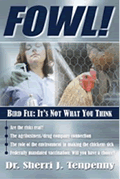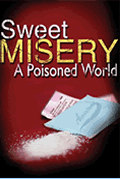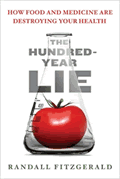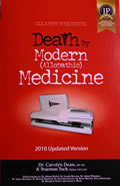Other
Tenpenny
Articles:
The Flu Season Campaign Begins
Vaccinations and The Right to Refuse
ANOTHER FLU VACCINE PUSH COMING SOON
Dr.
Sherri Tenpenny, DO
November 20, 2006
NewsWithViews.com
Just as busy shoppers start scrambling to put together their Christmas lists, the government will be urging them to add one more thing to their packed "to do" list: Get a flu shot.
CDC officials are planning a massive media blitz during the week of November 27 to December 3, 2006 to promote "National Influenza Vaccination Week." The flu shot campaign, which usually begins in August, has once again been derailed by delivery delays. Shots are normally given in September ostensibly to allow time for people to develop the antibody that is to protect them throughout the flu season. But the CDC has apparently rationalized that any time to get the shot is better than not getting it at all.
The director of the Centers for Disease Control, Dr. Julie Gerberding has gone on record saying, "We are concerned that we're going to have more doses of flu (vaccine) than we might use."[1] With all the hype that occurred earlier this year over the potential of a bird flu pandemic, manufacturers anticipated an unprecedented demand for the shot. In preparation, a record 110 million doses were produced for the 2006-07 season. Fearing that millions of those vials will be tossed in the trash-literally money down the drain-the CDC is pulling rank and pushing for a massive vaccination campaign to inject us will begin right after Thanksgiving.
The previous record, 95 million doses, was manufactured for the 2002-03 season. When 12 million flu shots went unused, one manufacturer quit making them. To prevent manufacturers from backing out of the flu shot business-the government will need them if a human form of bird flu arrives in the US-the CDC and other medical establishments, such as the American Medical Association and the American Academy of Pediatrics, will push hard to get everyone to roll up their sleeves and get in line. The organizations that claim to put public health first are showing their hands: Their role is to protect the profits of the pharmaceutical companies at the expense of the health of general public.
Guillian Barre: A real risk
A report was released on October 9, 2006 by the American Association of Neuromuscular and Electrodiagnostic Medicine (AANEM) called, "Guillain-Barre Syndrome (GBS) After Vaccination in United States." Of the 54 cases of documented GBS that occurred in 2004, 57% (31) of the patients had developed the condition after receiving an influenza vaccine.
GBS is an inflammatory disorder of the peripheral nerves (those outside the brain and spinal cord) characterized by an acute onset of weakness and paralysis. Called "ascending paralysis," it starts in the legs and moves up the body eventually attacking the muscles that aid in breathing. The result is often respiratory failure. Treatment frequently involves long term hospitalization in the intensive care unit, with most patients needing the assistance of a respirator. Residual neurological deficits can remain in up to 40% of people, and mortality ranges from 5%-10%.[2]
While officials downplay the actual risk, stating that the risk is negligible compared to the number of shots administered, if you happen to be the unfortunate one to contract this illness, the results can be horrific. An excerpt from a story reported on November 18, 2002 in The Public Health Reporter, published in Canada,[3] brings the vivid details to light:
"A 47-year old executive, Brain Claman, thought he was too busy to bother with the flu, so when his company offered the shots on site, he was one of the first in line. Two weeks later, he woke up with a severe headache and leg weakness, and by that same afternoon, he was placed in the intensive care unit and on a respirator, completely paralyzed. After eight months in the hospital, he had to relearn to walk. The report said that, in his own words, "Never in my wildest dreams -- or maybe I should say nightmares -- could I have imagined almost losing my life to the flu shot."
Like the expression "all politics is local," the reality of a vaccine reaction is personal. Vaccine research is designed to look for injury trends in large populations. One has to wonder if the epidemiological studies are specifically designed to dismiss the significance of an injury when it occurs in an individual. The VAERS database reportedly logs more than 12,000 injuries from vaccines per year. This does not prove causality; in fact, causality is difficult to prove. In my opinion, that is because the medical literature and the Vaccine Injury Compensation Table are stacked against identifying causality.
Injuries such as GBS are dramatic, and fortunately, they are uncommon overall. But knowing what comes through the needle of a flu shot should make each person pause. What is the bigger risk, the possibly getting the flu or the flu shot itself.
Flu
Shot Production: What's In That Needle?
(The following information is excerpted from Chapter 9 of FOWL! Bird
Flu: It's Not What You Think entitled "What's Coming Through That
Needle.")
After the influenza viruses are separated from the eggs they are grown in, they are inactivated (killed) with formaldehyde, a known carcinogen. The surface antigens, (H) and (N) are then "split" by a detergent called Triton� X-100. The process spreads the surface antigens apart, increasing the probability of developing an antibody response. Traces of Triton X-100, made by Dow Chemical, can remain in the vaccine solution. Product information on this compound states the following: "Excellent detergent, dispersant and emulsifier for oil-in-water systems. Uses: Household & industrial cleaners, paints & coatings, pulp & paper, textile, agrochemical, metal working fluids, oilfield chemicals.[4]
The suspension of viruses and chemicals is further concentrated in a centrifuge using a sucrose (table sugar) solution and then suspended in sodium phosphate-buffered isotonic salt solution. In one of the final steps, a 0.05 percent concentration of gelatin is added as a stabilizer, and in many cases, thimerosal, the mercury-based preservative, is still added to the multidose vials of the flu vaccine.[5] Some types of influenza vaccines also include 500 micrograms of gentamicin, a broad-spectrum antibiotic, added during the production process to inhibit the growth of bacteria that may be in the suspension.
Two other chemicals, tri-butylphosphate and polysorbate 80, then become part of the "chemical soup" of the vaccine. Tri-butylphosphate, a detergent and polysorbate 80, also known as Tween80�, is an emulsifier. Both are used to disrupt the surface of the virus, making the (H) and (N) antigens more accessible to the immune system. Polysorbate 80 is also found in ice creams and other "fake foods." Resin is added to ostensibly eliminate "substantial portions" of these chemicals, but undoubtedly, residuals of these chemicals remain in the vaccine when injected.
By the time the flu shot is ready for packaging, the solution contains the following: various egg proteins, viral contaminants from the eggs, Triton-X100, formaldehyde, resin, gelatin, tri-butylphosphate, polysorbate 80, and in some instances gentamicin. To preserve this chemical brew, in doses of up to 25 micrograms thimerosal (a mercury derivative) is still added to some of the shots. After detailing this vivid description of the manufacture of the influenza vaccine, the thought of injecting this into your body-or the body of your baby-should be repugnant.
For those not repulsed by the idea of injecting the previously described solution into your body, perhaps knowing that the vaccine won't prevent you from getting the flu will add to your perspective.
The fact that the flu shots are ineffective in every age group hardly seems to matter to CDC and others who continually promote their use. Multiple studies published in highly reputable publications have documented that flu shots are ineffective in all ages. For example, The Cochrane Collaboration produced a series of articles in 2005-and again an additional article published in the British Medical Journal, October 28, 2006[6] -that reviewed the published literature to evaluate the effectiveness of the flu shot. Nothing substantiating its usefulness was found. (Read the full story behind the lack of flu shot effectiveness here.
People across the country are waking up and speaking out against what they are allowing to be injected into their bodies, and the bodies of their children. They are no longer accepting that injecting viruses, bits of bacteria and traces of chemicals into their infants is a way to keep them well. Too many have personal experience with adverse effects to continue to accept that high vaccination rates and low infection rates are the only measure of Public Health.
|
Subscribe to the NewsWithViews Daily News Alerts! |
After the Thanksgiving holiday, when the news blares stories about the importance of the getting the flu shot and dutifully lists locations of local flu shot clinics, don't let it interrupt your day. Keep shopping and stay on task with your holiday chores. Both are much more productive uses of your time.
Footnotes:
1.
CDC Urges More People to Get Flu Shots. By Mike Stobbe. November 11,
2006. Associated Press
2.
Fanion, David. Guillain-Barr�
Syndrome
3.
"Flu shot left executive
paralyzed," by Andre Picard. Public Health Reporter. Monday, November
18, 2002, Page A1.
4.
"Octyphenol Ethoxylate," The Dow Chemical Company. (http://www.dow.com.)
5.
"Influenza Virus Vaccine Fluzone 2005-2006 Formula," package insert.
Aventis Pasteur (company name has since changed to Sanofi Pasteur
MSD. Update 14 February 2006).
6,
Jefferson, Thomas. Influenza vaccination: policy versus evidence.
BMJ 2006;333:912-915 (28 October)
�
2006 Sherri Tenpenny - All Rights Reserved
Dr. Sherri Tenpenny is respected as one of the country's most knowledgeable and outspoken physicians regarding the impact of vaccines on health. Through her education company, New Medical Awareness, LLC, she spreads her vision of retaining freedom of choice in healthcare, including the freedom to refuse vaccination. A portion of this article is an excerpt from her new book, FOWL! Bird Flu: It's Not What You Think, released in April, 2006. For daily updates on the bird flu, including the real reasons behind the hype, and a bi-weekly e-Newsletter with Dr. Tenpenny's commentary go to www.BirdFluHype.com
Dr. Tenpenny is a regular columnist for www.NewsWithViews.com. Her 3-hour vaccine DVD, Vaccines: The Risk, The Benefits and The Choices and her new book FOWL! are available through this site; other tapes and materials are available www.DrTenpenny.com
Website: www.DrTenpenny.com
Website: www.BirdFluHype.com
E-Mail: nmaseminars@aol.com
By the time the flu shot is ready for packaging, the solution contains the following: various egg proteins, viral contaminants from the eggs, Triton-X100, formaldehyde, resin, gelatin, tri-butylphosphate, polysorbate 80, and in some instances gentamicin.













